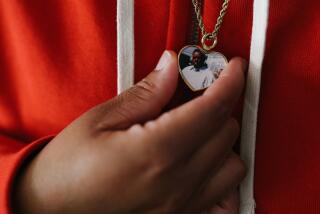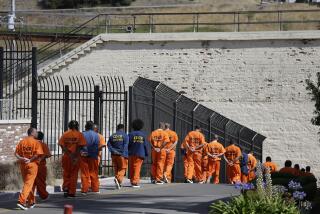Men’s Central Jail is an antique that should be replaced
The visits were two weeks apart. First, I toured the Men’s Central Jail in downtown Los Angeles. And then, on a family trip to San Francisco last week, I visited Alcatraz, which is now a national park.
One of the two old pens is hopelessly decrepit, with leaky pipes, bad wiring and a ridiculously outdated design.
That would be the Men’s Central Jail, which dates to 1963, the year Alcatraz ceased operating as a federal lockup.
Alcatraz had its own problems as a prison, and its isolation was responsible for exorbitant operating costs. But I couldn’t help but notice the more efficient layout at the former temporary home of Al Capone and Robert “Birdman” Stroud. Cells run along either side of broad walkways that allowed guards to keep an eye on hundreds of prisoners at once.
The Men’s Central Jail has long rows of cells facing a wall. With this linear design, there’s no way for guards to see into more than a few cells at a time That makes it harder to prevent suicides and inmate attacks on each other or on guards. It’s also hard to monitor abuse of inmates by guards, a problem to which the Los Angeles County Sheriff’s Department is no stranger.
“It’s clearly inefficient, and it’s arguably inhumane and unconstitutional,” Los Angeles County Supervisor Mark Ridley-Thomas told me this week.
The supervisors have perused options for demolishing and replacing the jail, perhaps with one of the modular, more circular designs that are now favored. The board is not known for its speed, but Ridley-Thomas, for one, said he wants to pick up the pace. In September, the U.S. Justice Department launched a civil rights investigation into a pattern of abuse of inmates in Los Angeles County jail facilities, and one possible outcome is for the feds to dictate remedies.
Of course, problems at the scandal-plagued Sheriff’s Department go well beyond jail design. The latest example of epic, head-shaking mismanagement on Sheriff Lee Baca’s watch was reported Sunday by my colleagues Robert Faturechi and Ben Poston. The department inexplicably hired dozens of officers — many of whom were assigned to jails — despite misconduct at other agencies. Among those handed guns and badges were 29 who had been fired or forced to resign elsewhere.
However that debacle plays out, the Men’s Central Jail is begging for a date with a wrecking ball. A county report estimated that a jail with a more practical design would require far fewer guards, for an annual staffing savings of $25 million. There would be an additional $10 million savings in operating and maintenance costs. And if a smarter design leads to fewer altercations and lawsuits, there could be a savings in legal costs.
Critics of proposals to spend more than $1 billion on a new jail say that we don’t need one, even if Men’s Central — home to 4,800 the day of my visit — is demolished. They say that the money should be spent instead on education and crime prevention, and that sentences of nonviolent offenders should be reduced and drug addiction and mental illness be treated as diseases rather than punishable crimes.
I’m for all of that, but I think we will need a new jail too, especially with the added load of state inmates serving county time due to the federal crackdown on overcrowded prisons. A new jail, done right, would have a mental health evaluation and referral center to reduce that population of inmates. It would have a veteran and homeless court, and a way for inmates to occasionally make court appearances by video, rather than being in transit all day for proceedings that often last a minute or two.
It would, in short, be everything the Men’s Central Jail and the other Los Angeles County facilities are not.
“This is an antiquated system,” a sheriff’s official said on my tour of the jail as we strolled past moldy walls and walked under a plastic tarp that was suspended from the ceiling to catch the trickle from bad plumbing.
Each day, beginning at 3 a.m., hundreds of inmates are herded out of cells and into jampacked holding tanks, where they await transportation to courtrooms all over the county. It’s a massive daily movement that is made more cumbersome and dangerous by the long corridors and poorly lit alcoves.
Electrical and plumbing repairs top $1.2 million a year at the Men’s Central Jail, and some replacement parts have to be custom-made because they are no longer manufactured. Teams of inmate plumbers help with the backlog of breakdowns, but it still takes up to five days for repairs.
One inmate told me that conditions are much better in the state prisons he’s been in, including San Quentin. He said his cell toilet has no running water, so he fills a plastic bag at his sink and dumps water into the commode to flush.
On one cell block, doors are solid except for two small openings. One inmate had draped a red blanket over the openings so no one could see inside. The guards said the inmate had some kind of mental issues, but he had been sent to the Men’s Central Jail anyway. The vast majority of inmates with mental illness — more than 3,000 of them — are housed across the street at the Twin Towers facility, which has a modular design but problems of its own. Among other things, there’s no private area for counseling and inmates often go weeks between therapy sessions.
When I suggested the guy behind the red blanket might be a suicide waiting to happen, none of the jailers could disagree. One guard said they had a suicide not all that long ago.
So when will county supervisors finally get around to a plan of action? Ridley-Thomas said he’s shooting for early in the new year.
Until then, here’s how one jailer summed up the Men’s Central Jail at the end of my tour:
“We respectfully call it the dungeon.”
More to Read
Start your day right
Sign up for Essential California for news, features and recommendations from the L.A. Times and beyond in your inbox six days a week.
You may occasionally receive promotional content from the Los Angeles Times.







